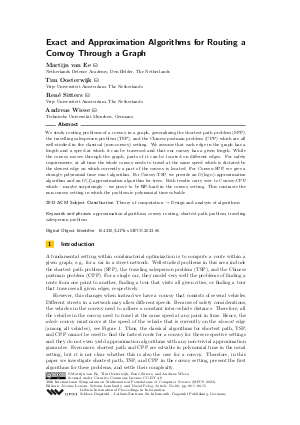Exact and Approximation Algorithms for Routing a Convoy Through a Graph
Authors Martijn van Ee, Tim Oosterwijk, René Sitters, Andreas Wiese
-
Part of:
Volume:
48th International Symposium on Mathematical Foundations of Computer Science (MFCS 2023)
Part of: Series: Leibniz International Proceedings in Informatics (LIPIcs)
Part of: Conference: Mathematical Foundations of Computer Science (MFCS) - License:
 Creative Commons Attribution 4.0 International license
Creative Commons Attribution 4.0 International license
- Publication Date: 2023-08-21
File

PDF
LIPIcs.MFCS.2023.86.pdf
- Filesize: 0.6 MB
- 15 pages
Document Identifiers
Subject Classification
ACM Subject Classification
- Theory of computation → Design and analysis of algorithms
Keywords
- approximation algorithms
- convoy routing
- shortest path problem
- traveling salesperson problem
Metrics
- Access Statistics
-
Total Accesses (updated on a weekly basis)
0Document
0Metadata
Abstract
We study routing problems of a convoy in a graph, generalizing the shortest path problem (SPP), the travelling salesperson problem (TSP), and the Chinese postman problem (CPP) which are all well-studied in the classical (non-convoy) setting. We assume that each edge in the graph has a length and a speed at which it can be traversed and that our convoy has a given length. While the convoy moves through the graph, parts of it can be located on different edges. For safety requirements, at all time the whole convoy needs to travel at the same speed which is dictated by the slowest edge on which currently a part of the convoy is located. For Convoy-SPP, we give a strongly polynomial time exact algorithm. For Convoy-TSP, we provide an O(log n)-approximation algorithm and an O(1)-approximation algorithm for trees. Both results carry over to Convoy-CPP which - maybe surprisingly - we prove to be NP-hard in the convoy setting. This contrasts the non-convoy setting in which the problem is polynomial time solvable.
Cite As Get BibTex
Martijn van Ee, Tim Oosterwijk, René Sitters, and Andreas Wiese. Exact and Approximation Algorithms for Routing a Convoy Through a Graph. In 48th International Symposium on Mathematical Foundations of Computer Science (MFCS 2023). Leibniz International Proceedings in Informatics (LIPIcs), Volume 272, pp. 86:1-86:15, Schloss Dagstuhl – Leibniz-Zentrum für Informatik (2023)
https://doi.org/10.4230/LIPIcs.MFCS.2023.86
BibTex
@InProceedings{vanee_et_al:LIPIcs.MFCS.2023.86,
author = {van Ee, Martijn and Oosterwijk, Tim and Sitters, Ren\'{e} and Wiese, Andreas},
title = {{Exact and Approximation Algorithms for Routing a Convoy Through a Graph}},
booktitle = {48th International Symposium on Mathematical Foundations of Computer Science (MFCS 2023)},
pages = {86:1--86:15},
series = {Leibniz International Proceedings in Informatics (LIPIcs)},
ISBN = {978-3-95977-292-1},
ISSN = {1868-8969},
year = {2023},
volume = {272},
editor = {Leroux, J\'{e}r\^{o}me and Lombardy, Sylvain and Peleg, David},
publisher = {Schloss Dagstuhl -- Leibniz-Zentrum f{\"u}r Informatik},
address = {Dagstuhl, Germany},
URL = {https://drops.dagstuhl.de/entities/document/10.4230/LIPIcs.MFCS.2023.86},
URN = {urn:nbn:de:0030-drops-186205},
doi = {10.4230/LIPIcs.MFCS.2023.86},
annote = {Keywords: approximation algorithms, convoy routing, shortest path problem, traveling salesperson problem}
}
Author Details
References
-
Pierre Chardaire, Geoff P. McKeown, S.A. Verity-Harrison, and S.B. Richardson. Solving a time-space network formulation for the convoy movement problem. Operations research, 53(2):219-230, 2005.

-
Jack Edmonds. The Chinese postman problem. Operations Research, 13:73-77, 1965.

-
Jack Edmonds and Ellis L. Johnson. Matching, Euler tours and the Chinese postman. Mathematical programming, 5(1):88-124, 1973.

-
Michael R. Garey and David S. Johnson. Computers and intractability, volume 174. Freeman San Francisco, 1979.

-
Michael Held and Richard M. Karp. The traveling-salesman problem and minimum spanning trees. Operations Research, 18(6):1138-1162, 1970.

-
Anna R. Karlin, Nathan Klein, and Shayan Oveis Gharan. A (slightly) improved approximation algorithm for metric TSP. In Proceedings of the 53rd Annual ACM SIGACT Symposium on Theory of Computing, pages 32-45, 2021.

-
Michael Hart Moore. On the fastest route for convoy-type traffic in flowrate-constrained networks. Transportation Science, 10(2):113-124, 1976.

-
Dong Hwan Oh, R. Kevin Wood, and Young Hoon Lee. Optimal interdiction of a ground convoy. Military Operations Research, 23(2):5-18, 2018.

-
Christos H. Papadimitriou. On the complexity of edge traversing. Journal of the ACM, 23:544-554, 1976.

-
Marta Pascoal, M. Eugénia V. Captivo, and João C.N. Clímaco. A comprehensive survey on the quickest path problem. Annals of Operations Research, 147(1):5-21, 2006.

-
P.N. Ram Kumar and T.T. Narendran. A mathematical approach for variable speed convoy movement problem (CMP). Defense & Security Analysis, 25(2):137-155, 2009.

-
Martin Skutella. An introduction to network flows over time. In William Cook, László Lovász, and Jens Vygen, editors, Research Trends in Combinatorial Optimization: Bonn 2008, pages 451-482. Springer, Berlin, Heidelberg, 2009.

-
Petr Slavík. The errand scheduling problem, 1997. Technical report.

-
Ola Svensson, Jakub Tarnawski, and László A Végh. A constant-factor approximation algorithm for the asymmetric traveling salesman problem. Journal of the ACM (JACM), 67(6):1-53, 2020.

-
Vera Traub and Jens Vygen. An improved approximation algorithm for the asymmetric traveling salesman problem. SIAM Journal on Computing, 51(1):139-173, 2022.

